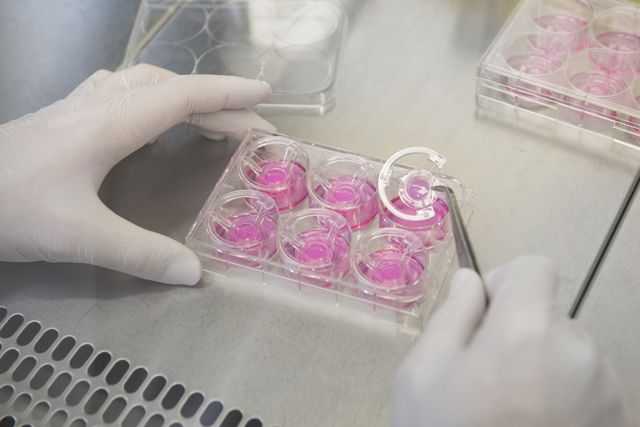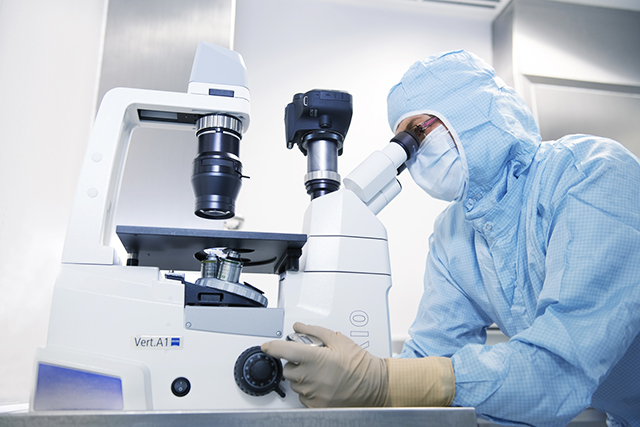Research against the corona virus -
tissue models for rapid drug testing
The pandemic caused by SARS-CoV-2 (severe acute respiratory syndrome coronavirus 2) is placing unprecedented restrictions on public life and economy. The global research efforts to fill the knowledge gaps regarding the new pathogen and to develop effective therapies are correspondingly large. In Wuerzburg, too, researchers from the Fraunhofer Translational Center for Regenerative Therapies are working together with the virologist Prof. Dr. Bodem from the University of Wuerzburg to identify active substances against the virus.
The tissue models from the Fraunhofer Translational Center for Regenerative Therapies (TLC-RT), which has been part of the Fraunhofer Institute for Silicate Research ISC in Würzburg since 2017, actually look quite unspectacular. Cell culture scaffolds are stored in light pink nutrient solution in transparent plastic plates with circular wells. But behind the sober appearance there is something hidden that could revolutionize the development of active ingredients and drugs. For example, not only individual cells of the digestive tract, but intestinal organoids containing all essential cells of the intestinal mucosa, or not only individual cells from the respiratory tract, but a cell model of the human, ciliated respiratory mucosa, which is the primary target tissue of SARS-CoV-2.
Rapid drug testing with tissue models
Currently, the Fraunhofer team, together with Prof. Bodem's research group at the University Institute for Virology and Immunobiology in Wuerzburg, is investigating defined substances for their effectiveness against SARS-CoV-2, the virus responsible for the current corona/COVID-19-pandemic. "Together with our colleagues from virology, we are analyzing whether the addition of certain substances can inhibit the viral replication in the tissue models. We are also investigating how an infection with SARS-CoV-2 affects the functionality - e.g. barrier function or mucus formation - of respiratory tract models. With our airway tissue models, we thus obtain a comprehensive picture of possible processes that could also occur in humans after an infection," says project leader Dr. Maria Steinke of TLC-RT. "In a first step, it would already be helpful to find active substances that weaken the virus and strengthen and stabilize the body's own immune system". The researchers and their project partners also plan to investigate substances that have already been approved for other diseases, as this would help to shorten the usual and necessary time-consuming and costly clinical approval process. Thus, they hope to identify compounds for SARS-CoV-2 therapy as quickly as possible.
Research approach for specific early warning test
Early warning tests that react reliably to SARS-CoV-2 at a very early stage of the infection could also be a further component in the fight against the corona pandemic. "The fact that SARS-CoV-2-infected people often report gastrointestinal symptoms at a relatively early stage of the disease could possibly be useful. Whether and how this is related to the corona virus is still unclear. To fill this knowledge gap, one could use our model systems of the gastrointestinal tract," adds PD Dr. Marco Metzger, head of the Fraunhofer TLC-RT. At present, a number of project applications have been submitted to the Federal Ministry of Education and Research (BMBF) and the German Research Foundation (DFG) with the cooperation partners from Wuerzburg and Leipzig in order to be able to continue financing this work.
Reliable data with less animal experiments
With these human 3D tissue models, the TLC-RT researchers are at the forefront of biomedical research. "We use these cell-based models, for example, to test active ingredients, drugs or even cosmetics for research and industry. As a result, far less animal experiments are required and the results of the tests can be transferred more reliably to humans because we can use human cells from cell banks for the tissue models," explains Prof. Dr. Gerhard Sextl, Director of the Fraunhofer ISC. The models are of particular interest for the pre-clinical phase of drug development aiming to identify the appropriate active substances for a particular disease quickly and reliably. Here, the researchers aim to replace animal experiments or very simplified 2D cell culture systems that have been used so far.
Literature
Lodes N, Seidensticker K, Perniss A, Nietzer S, Oberwinkler H, May T, Walles T, Hebestreit H, Hackenberg S, Steinke M. »Investigation on Ciliary Functionality of Different Airway Epithelial Cell Lines in Three-Dimensional Cell Culture«. Tissue Eng Part A. 2019 Dec 27. doi: 10.1089/ten.TEA
Schweinlin S, Wilhelm S, Schwedhelm I, Hansmann J, Ritscher R, Jurowich C, Walles H, Metzger M. »Development of an advanced primary human in vitro model of the small intestine«. Tissue Engineering Part C: Methods 2016 Sep;22(9):873-83.

